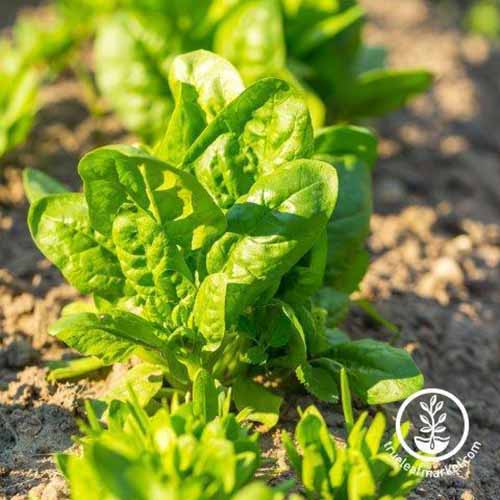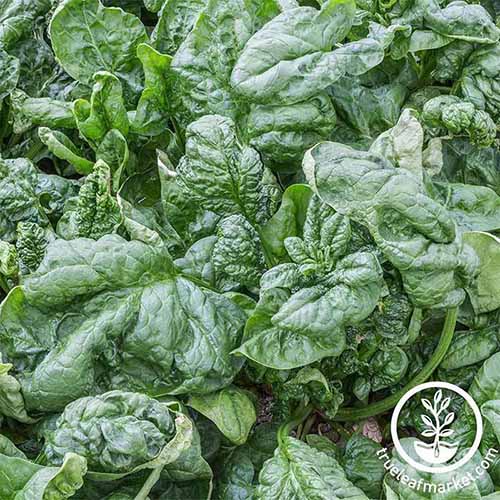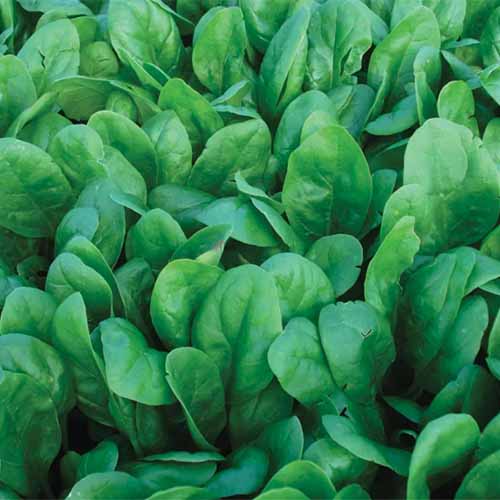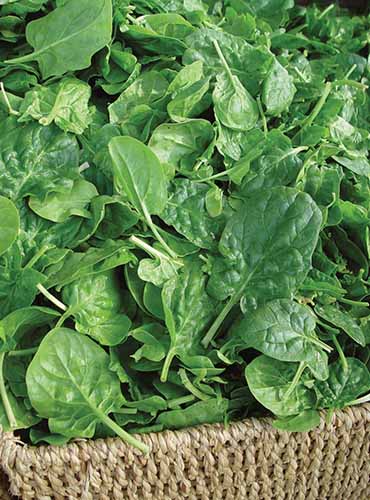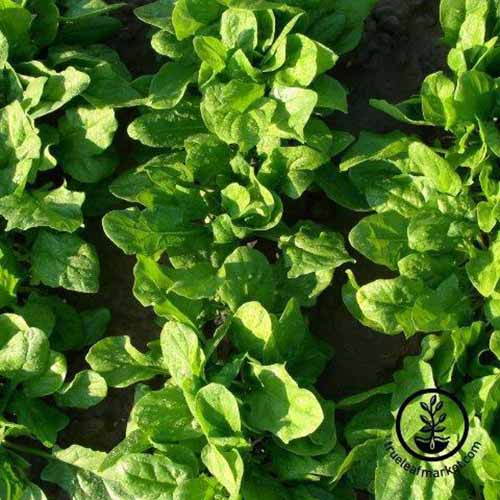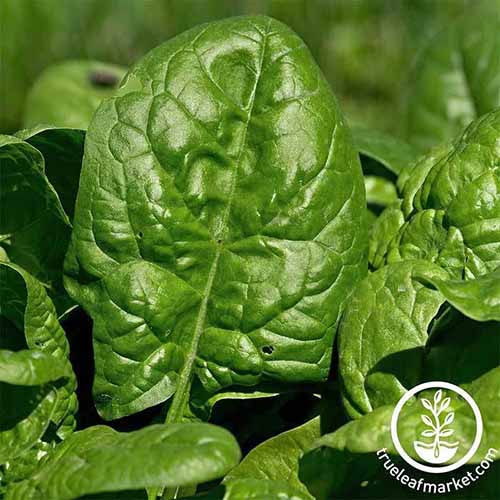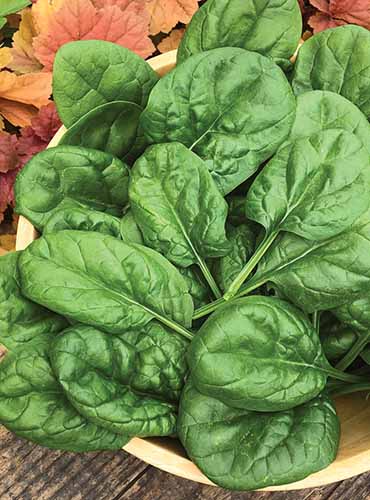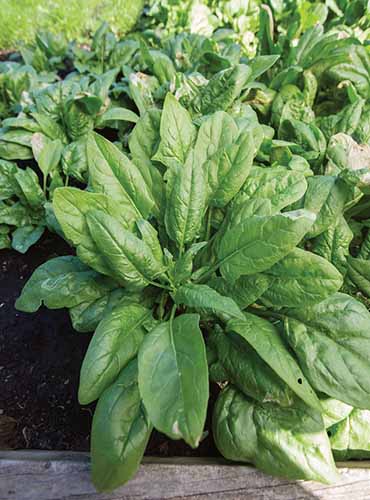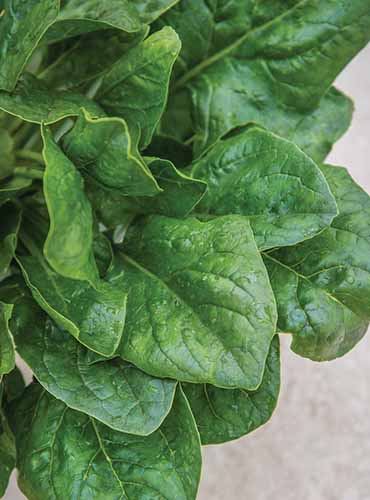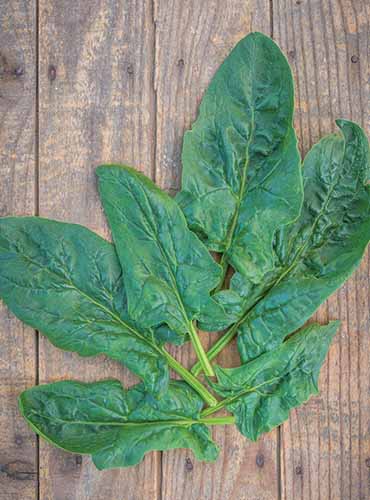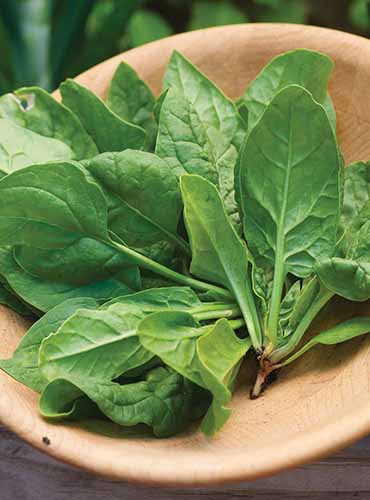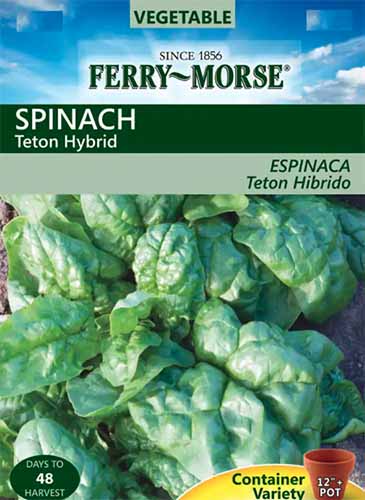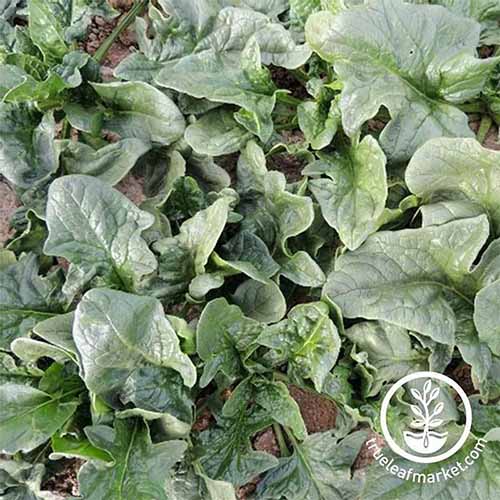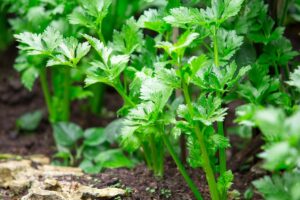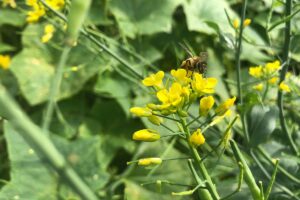Good ol’ spinach. It’s so nutritious that it has become an avatar for healthy eating. It thrives in weather too cold for lettuce, and it matures so fast that you can have multiple harvests each season.
There’s so much to love about the versatile little greens.
Know what I don’t like about spinach? There are just so many darn good cultivars to choose from!
I have stood at the seed display at my local nursery, paralyzed with indecision. Eventually, I just selected a half dozen packets at random and skedaddled out of there. You can never have too many spinach plants, right?
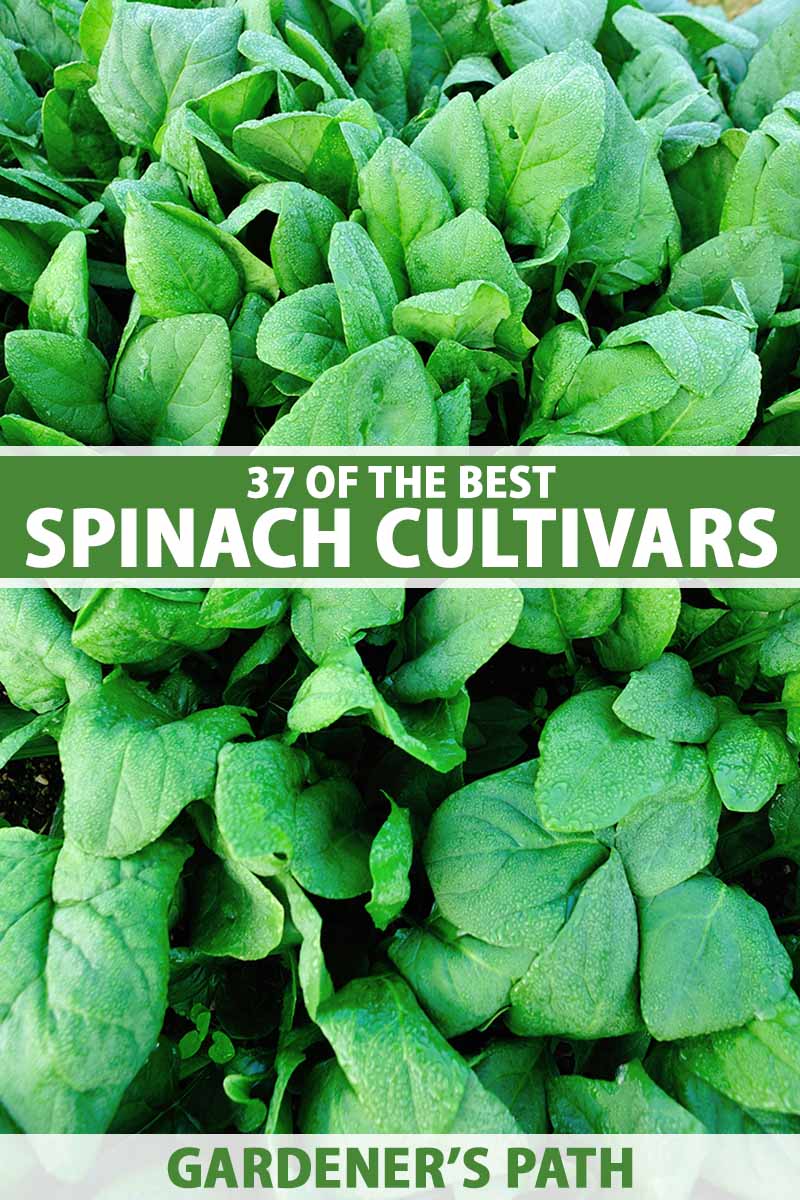
We link to vendors to help you find relevant products. If you buy from one of our links, we may earn a commission.
To save you from enduring the same harrowing experience, we’ve compiled 37 of the best options out there.
Here are the cultivars we’ll discuss up ahead:
37 Favorite Spinach Varieties
Spinach is categorized by leaf type. Savoyed types are heavily wrinkled, while semi-savoyed varieties are more subtly wrinkled. Flat (or smooth) types, as you probably guessed, lack wrinkling.
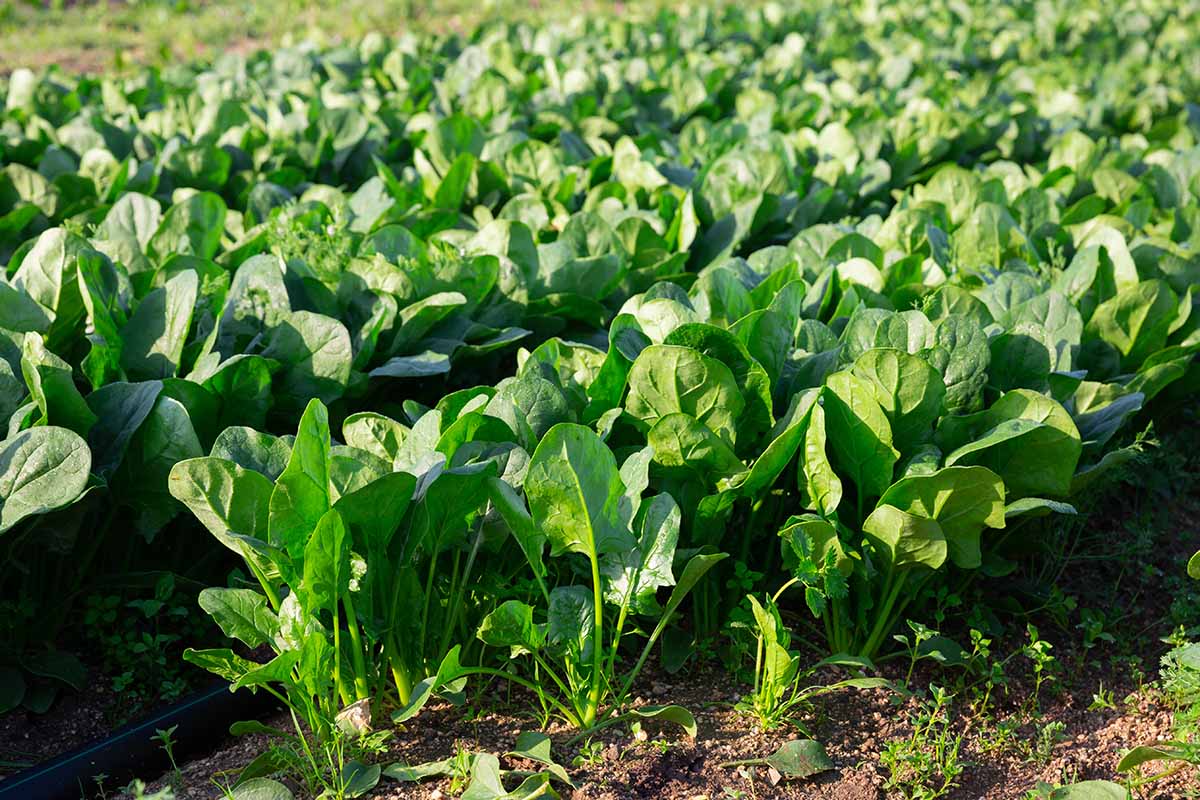
Additionally, there is usually a range of days that seed purveyors and packets will tell you is suitable for harvesting your spinach.
The earlier date is for harvesting the tender baby leaves, and the later date is for cutting the entire mature plant all at once.
Downy mildew often plagues spinach, especially in the winter.
If you struggle with this in the garden, look for a resistant cultivar and be sure to rotate your crops so you don’t grow spinach more than once every three years in the same place.
On to the cultivars!
1. Acadia
The semi-savoy ‘Acadia’ has glossy, cupped, oval, deep green leaves. Each leaf is fairly petite, which makes this hybrid perfect for sandwiches and salads.
You can start harvesting in just 27 days, though it’s ready to be harvested at its mature size in 45 days. It’s resistant to bolting and downy mildew.
2. A La Carte
You’ll definitely want to pick ‘A La Carte’ off your next seed-buying menu.
This savoy hybrid has particularly flavorful foliage and the shape is distinctly like that of lamb’s-quarter (they are related, after all), which makes it a pretty addition to salads or as a garnish.
You can start plucking leaves at 30 days or wait 45 days to cut the whole plant at once.
Burpee carries packets of 300 seeds. That may sound like a lot, but once you taste this gem, you’ll probably want a ton more.
3. America
This heirloom savoy cultivar is slow to bolt, tolerant of heat and drought, and resists mildew, which helped make it an All-America Selections winner in the vegetable class in 1952.
Ready to harvest in 43 to 55 days, it has thick, oval leaves.
True Leaf Market has four-gram, as well as quarter-, one-, and four-ounce packets available so you can bring this patriotic winner home.
4. Auroch
This hybrid cultivar has long stems and an upright growth habit, with thin, flat, oval-shaped leaves.
Ready in a mere 24 days (or 30 for mature leaves), it’s resistant to downy mildew but doesn’t do well in the heat, so grow this one during the late fall, winter, or early spring.
5. Avon
Sometimes the fast-growing varieties are also the ones that bolt quickly. But not the hybrid, semi-savoy ‘Avon.’

It grows fast, with baby leaves that are ready in just 25 days. The plant matures 20 days later, and it’s slow to bolt.
You can find packets of 200 seeds available from Everwilde Farms via Amazon.
6. Baby’s Leaf
Nobody puts baby in the corner… unless that’s the best spot in your garden.
A flat-leaf type, ‘Baby’s Leaf’ stands out because it has extremely short stems, leaving you with lots of leafy goodness without having to chop off and waste any long stems that you’re not a fan of.
This hybrid is ready in 30 to 40 days.
‘Baby’s Leaf’ is a Burpee exclusive, so snag some seeds via their website if this one calls your name.
7. Bloomsdale Long Standing
‘Bloomsdale Long Standing’ has been a popular option for over a century, for good reason. The thick, meaty leaves have a rich, nutty flavor, and they’re excellent for cooking and freezing.
True to its name, this heirloom, heavily savoyed-type takes longer than most to mature, at 30 to 50 days. It’s also extremely heat tolerant for spinach.
True Leaf Market offers eight-gram, 15-gram, four-ounce, one-pound, five-pound, and 25-pound packets.
8. Butterflay
‘Butterflay’ is so vivid green that they should have named it glowing emerald or something. The massive semi-savoyed leaves look like huge gems in the garden.

This heirloom is a reliable germinator, resists bolting, and is exceptionally cold tolerant. It can even hang out in the garden with chilly weather lovers like kale and chard. And it’s ready to pick in 20 to 45 days.
Pick up packets of 225 seeds from Seedz via Amazon.
9. Carmel
The semi-savoyed leaves on ‘Carmel’ are incredibly uniform in size and extremely upright, which makes this one easy to harvest.

Ready in just 25 days for baby leaves and 40 for mature plants, this hybrid is a reliable germinator that’s resistant to downy mildew and slow to bolt.
David’s Garden Seeds can hook you up with packages of 200 seeds available via Amazon.
10. Corvair
Resistant to downy mildew and slow to bolt, growing ‘Corvair’ feels like a leisurely drive down a sunny highway with the top down.
The large, oval leaves of this hybrid are flat and crispy, and they can be plucked from the plant in 30 to 45 days.
Though you can also leave them in the garden a week or two longer if you need to, and the plants won’t surprise you and quickly go to seed.
Pop on over to Home Depot to purchase a pack of seeds.
11. Crocodile
Like the animal this one was named after, ‘Crocodile’ doesn’t mind languishing around in the heat. If you live somewhere where you’ve struggled to raise spinach because it’s too hot, give this semi-savoyed hybrid a try.
Bonus: it’s also resistant to downy mildew. And unlike its namesake, you’ll be eager to get your hands on the large, upright foliage, which is ready in 25 to 55 days.
12. Double Choice
Rust-resistant with large, thick, and mild leaves, and ready in 35 to 40 days, flat-leaf ‘Double Choice’ offers many reasons why you should pick it.
This hybrid is another Burpee exclusive, so visit their storefront for a pack of 350 seeds.
13. Double Take
You know what I’m about to say, right? ‘Double Take’ will have you doing just that once you see the large, smooth, dark green leaves with their distinct goosefoot-like shape.
Then, when you realize that this cultivar’s downy mildew resistant as well – you guessed it! – you’ll be doing a triple take.
Ready in 40 to 50 days, the leaves are tender enough for salads but robust enough for steaming. Pick up this Burpee exclusive hybrid in packs of 200.
14. Early Hybrid No. 7
What it lacks in an interesting name (and yes, it is a hybrid), this type makes up for with its resistance to downy mildew and mosaic virus.
Ready in 35 to 40 days, these extremely vigorous plants have a sprawling growth habit, and semi-savoyed leaves.
Pick up a four-gram, quarter-ounce, one-ounce, four-ounce, or pound-size packet at True Leaf Market.
15. Emperor
Regal ‘Emperor’ has semi-savoy leaves on upright stalks. Plus, it’s built a fortress against downy mildew, so you don’t have to worry about the common disease destroying your spinach.
That’s enough to celebrate it, but this hybrid also has a high germination rate to top it all off.

Host this leader among spinach in your garden by bringing home a pack of 200 seeds from David’s Garden Seeds via Amazon.
16. Flamingo
This bird isn’t timid. It’s slow to bolt and resistant to downy mildew.
Flamingoes have a reputation as heat-lovers, but like Pink Floyd, the bird that made its home in the freezing waters of the Great Salt Lake, this particular ‘Flamingo’ is much more tolerant of cold weather than many of its fellow creatures as well.

The arrow-like leaves of this hybrid even resemble the feet of the famous pink wading birds. Expect a harvest in 25 to 40 days.
Create your own flock of spinach flamingos by bringing home 200 seeds from David’s Garden Seeds via Amazon.
17. Galilee
‘Galilee’ is exceptionally heat-tolerant, which shouldn’t come as a surprise since it was cultivated to grow in the heat of Israel.
Ready in 35 to 45 days, this flat-leaf type has extremely large, arrow-shaped leaves with sharp tips.
18. Gazelle
As swift as the animal it was named for, ‘Gazelle’ is ready to devour in just over three weeks, or you can wait until 35 days for mature leaves.
This semi-savoy hybrid cultivar resists downy mildew and has upright, uniform leaves, which makes it easy to harvest and bunch together.
19. Giant Noble
Whoever named this cultivar wasn’t kidding. It’s huge! Each individual leaf can be six inches long and the plant itself is two feet wide.
This plant is a hybrid with smooth leaves, which is why it’s sometimes called smooth leaf spinach.
The extreme size of these makes it perfect for cooking, plus it’s slow to bolt, which is probably part of the reason why it has been a super popular variety for over 100 years.
You can harvest this veggie at 35 days, but why not wait the full 50 days so you can enjoy the full-sized leaves?
Make it yours by grabbing an eight-gram, four-ounce, or one-, five-, or 25-pound package at True Leaf Market.
20. Hammerhead
Before we get to know ‘Hammerhead,’ just be aware that it’s quick to bolt.
That doesn’t mean you should avoid it, just know that it’s best for planting in the early spring or late fall. That said, it’s resistant to downy mildew and rust.

The foliage is large, cupped, savoyed, and oval-shaped. It’s ready to pluck in 27 days, or 35 for full-sized leaves.
David’s Garden Seeds via Amazon carries packages of 200 seeds to add to your garden.
21. Harmony
If you’re looking for a pretty addition to salads or a garnish for the plate, this option is sure to sound sweet to you. With large, oval, semi-savoyed leaves, ‘Harmony’ is a hybrid that’s ready in 35 to 42 days.
While the dark greens are extremely delicious, they’re also undeniably pretty – you’ll be singing their praises!
Bring tranquility to your garden by nabbing a pack of seeds at Burpee.
22. Kolibri
Resistant to downy mildew, ‘Kolibri’ is one of the best options if you plan to use your spinach as a cut-and-come-again crop. The semi-savoyed leaves repopulate rapidly, replacing the ones you’ve already harvested.

The young leaves of this hybrid are ready in a month, though you can wait 45 days for fully-formed leaves, too.
Can’t wait to dig in? Packages of 200 seeds are available from David’s Garden Seeds via Amazon.
23. Lizard
To be honest, the idea of slicing into something named ‘Lizard’ really doesn’t appeal to me that much, but it’s okay to just ignore the name. This smooth-leaf, hybrid cultivar is excellent.
Like the reptile it’s named for, this leafy veg doesn’t mind lounging around in the sun, and it won’t bolt in the heat. It resists downy mildew and can be harvested at four weeks, or after it’s full-sized at 45 days.
The leaves are an attractive oval shape with a pointed tip in a deep, dark green color.
24. Merlo Nero
This hybrid veggie has massive, dark green, arrow-shaped leaves. It bolts in the heat, so plant it in early spring or late fall.
So long as you nail the timing, you’ll be treated to meaty, flavorful, fully savoyed leaves in just 35 to 45 days.
25. Palco
Resistant to both bolting and downy mildew, this is a reliable germinator with large leaves.
This hybrid is excellent for beginners and seasoned spinach growers alike thanks to its ease of growing and its rich flavor. It features semi-savoyed leaves with an upright growth habit.
26. Persius
If you like to cook or freeze your greens, this is the cultivar for you. The thick leaves do well when processed.
Poetry in motion, the plant is high-yielding with smooth, long, pointed leaves on long stems.
Baby leaves are ready in 45 days, or give the plants an extra 15 days to mature completely. It’s resistant to downy mildew as well.
Visit Burpee to purchase packets of 250 seeds.
27. Red Cardinal
Spinach is beautiful in its own understated way. But ‘Red Cardinal’ is a bit showier, just like the bold red bird that it’s named for.
This hybrid has rounded, flat leaves with an arched tip and bright red stems that extend up the midvein. The leaves are ready in just 25 days, or 40 for mature ones.
28. Red Tabby
With large, arrow-shaped, deep green leaves, this spinach cultivar is already good-looking. But add in the dark red stems and veins, and you have an exceptionally stunning veggie. It almost looks like a tiny Swiss chard plant.
It has an upright habit and it’s highly resistant to downy mildew. This hybrid is ready for harvest in 31 to 45 days.
29. Reflect
Extremely resistant to downy mildew and slow to bolt, ‘Reflect’ will have you contemplating your next meal.
And you won’t have to wait too long. This one is ready in just four weeks, or give it another 10 days to mature fully. A semi-savoy hybrid, it has cupped, round leaves.
30. Regiment
With its thick, oval foliage with slightly pointed tips, this hybrid is ready for harvest in just three weeks, or it takes about 37 days to reach full size. It’s resistant to downy mildew and bolting.
As one of the quickest growing types of spinach on this list, you can time your picking or succession planting so you will have continual harvests throughout the spring and fall.
31. Riverside
If a flat, smooth, deep green leaf with a gently pointed shape sounds like what you’re looking for, then make your way to the ‘Riverside.’ It’s not all about looks, though.
The greens have a smooth, rich flavor, and this plant is resistant to downy mildew and bolting in hot weather.
This hybrid cultivar is particularly excellent as a baby green, and ready for harvest in 30 to 45 days.
Burpee has packets of 250 seeds available so you can bring this lovely option home.
32. Seaside
Growing spinach isn’t really a challenging endeavor to begin with, but ‘Seaside’ ensures particularly smooth sailing.
The hybrid plant resists downy mildew and bolting, but where it really shines is with its uniform, medium-sized leaves that grow extremely upright, like little green sails in the garden.
That means harvesting is easy. Plus, it germinates reliably and produces lots of leaves on a single plant, thanks to a particularly dense growth habit.
It’s exceptional as a baby green and can be harvested in 25 days, and it will keep producing new leaves for weeks to come – as long as the weather is right.
Plant seeds in succession and you can be drowning in greens for a majority of the year.
If you prefer to wait for the leaves to mature, they’re ready in 40 days, and they take on a lovely arrowhead shape when they reach full size.
Sail on over to Burpee to scoop up 250 seeds for your garden.
33. Space
This hybrid cultivar is so tough and resilient, it’s like it was bred in a lab to be the perfect spinach. It is one of the most heat- and cold-tolerant types of spinach you can find.
It’s resistant to mildew, pests don’t seem to trouble it, and it germinates so reliably that you can practically toss the seeds in the garden and forget them until picking time.
The arrow-shaped, semi-savoyed leaves are ready for liftoff in just 40 days, unless you decide to launch them as baby greens. In that case, you can begin the countdown at just 25 days.
This is – hands down – my favorite all-around spinach. When other cultivars bolt or succumb to disease, it’s just over in the corner doing its thing.
Sound good? Rocket straight to Burpee for packs of 300 seeds.
34. Teton
Like the craggy mountains it’s named for, ‘Teton’ hybrid spinach has numerous peaks and valleys in its semi-savoyed leaves.
This is a heavy producer that resists bolting and downy mildew. Thanks to its upright growth habit, the greens are easy to harvest and ready in 30 days. Mature leaves take 45 days to reach their full size.
Conquer this mountain by heading to Home Depot to nab some seeds.
35. Tyee
‘Tyee’ is a semi-savoy type with thick, oval, exceptionally dark leaves. It is less likely to bolt in the heat than many other cultivars and it resists downy mildew. And it’s ready to pick in 30 to 45 days.

You can snap up this hybrid catch of the day from Hometown Seeds via Amazon, where you’ll find packs of 250 seeds.
36. Viroflay
‘Viroflay’ comes to us from 1800s Paris, and if you’re looking for a cultivar with massive leaves, look no further than this hybrid.
A single leaf can grow up to 10 inches in length, but that doesn’t mean you’ll be waiting forever to start eating this “monster spinach.” The semi-savoyed leaves are ready in 40 to 50 days.
The plant is lower in oxalic acid than many other cultivars, so it has a sweet, mild flavor.
Bring this Parisian treasure to your home by visiting True Leaf Market. They carry four-gram, four-ounce, one-pound, and five-pound packages.
37. Woodpecker
‘Woodpecker’ is your classic, smooth, oval leaf type. The hybrid plant has an upright habit and is slow to bolt. It’s also exceptionally resistant to downy mildew.
You can start plucking in as few as 25 days, or wait 35 days for mature leaves.
So Many Choices, So Little Time
There you have it, 37 excellent options for your spinach patch. You can’t go wrong with any of them, but hopefully we’ve helped you to narrow down the right option for your needs.
If so, be sure to tell us which one (or two, or three) you went with in the comments!
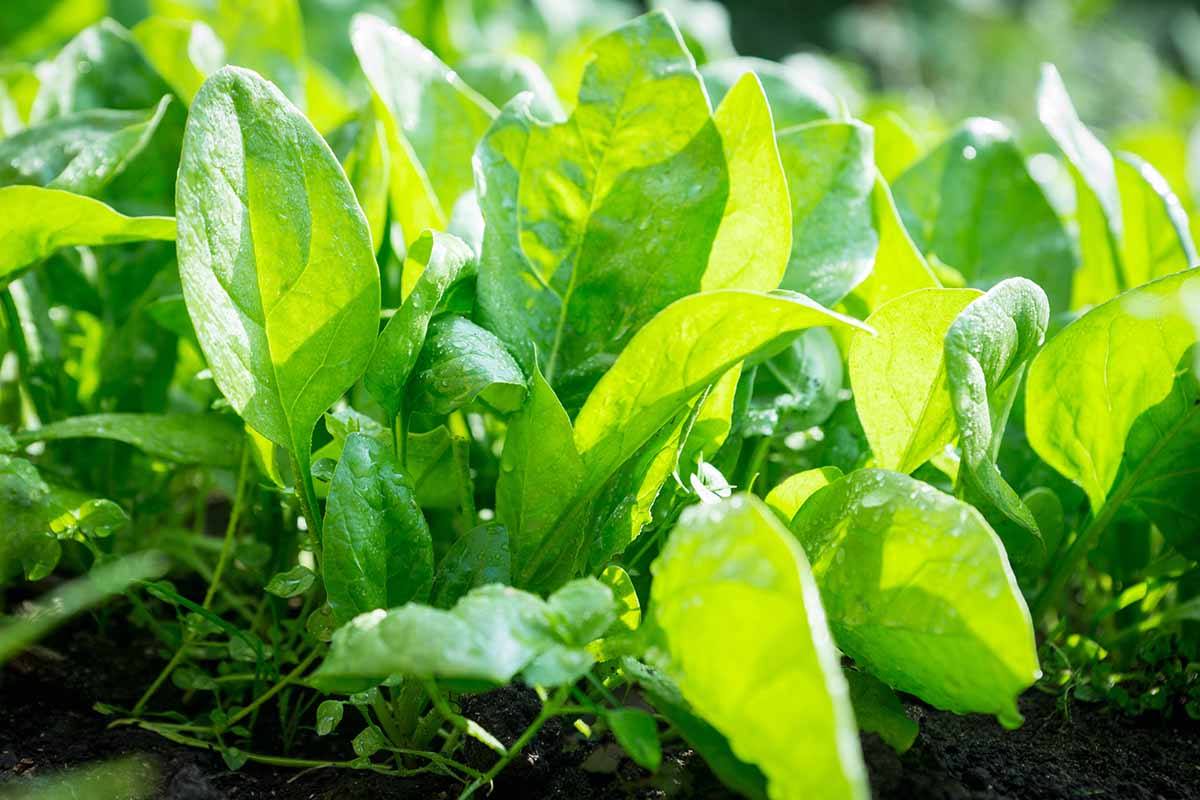
Honestly, I can’t imagine my garden each year without at least one round of ‘Red Cardinal’ and ‘Space.’ I usually toss in a little ‘Viroflay’ too, just to convert the spinach-haters out there with my favorite deconstructed spinach dip.
Want the recipe? Combine eight ounces of cream cheese and 12 ounces of sour cream with a packet of onion dip seasoning and a small can of water chestnuts, chopped. Let it sit for an hour.
Cut a loaf of French bread down the middle and slather the dip on top of the bottom half, then heap washed spinach leaves on top of the dip. Rip up the remaining half of the French bread and use the pieces to scoop up the dip mixture.
Then, as you digest, you might want to learn a bit more about growing spinach in the following guides:

